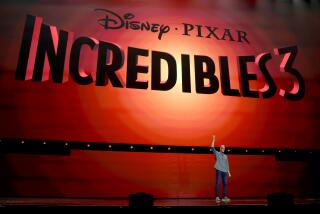Studio adding to its repertoire
DreamWorks Animation SKG Inc. is dreaming big.
The studio behind the hit films “Madagascar” and “Kung Fu Panda,” seeking to expand beyond its core animation movie business, is making an aggressive push into television, touring musicals, theme park attractions and even a Cirque du Soleil-style revue inspired by “Kung Fu Panda.”
DreamWorks’ expansion comes at a time when many other Hollywood studios are retrenching and signals to some investors that the company may be positioning itself for a sale once the economy recovers. The Glendale-based film and TV producer headed by Jeffrey Katzenberg and spun off from DreamWorks SKG in 2004 is one of only two smaller publicly owned independent studios left in an industry consolidated among a handful of major players.
Katzenberg has told analysts the company is not for sale at this time but has been increasingly vocal about the company’s strategy to leverage its core characters beyond the big screen.
“We think our content gives us the opportunity to connect with audiences in unique and innovative ways that have never been seen before,” the DreamWorks chief executive told analysts recently.
Behind the move is DreamWorks’ desire to create a more reliable revenue stream to reduce its dependence on the outcome of only about two movies a year.
With industrywide DVD sales in a slide, the studio is also facing increased outside pressure to broaden the scope of its business.
DreamWorks recently announced that it would produce an extra film every other year, boosting its biannual output. The studio is pushing into television, where its new animated series on Nickelodeon, “The Penguins of Madagascar,” has quickly become a hit for the cable channel.
Although DreamWorks had long planned to diversify, its ability to do so was held back by an uneven track record at the box office, which has been a nagging concern for investors. The studio, for example, followed up its 2005 hit “Madagascar” with the 2006 box-office flop “Flushed Away,” for which it was forced to take a write-down.
But with 2008’s “Kung Fu Panda,” which pulled in $632 million at the worldwide box office, DreamWorks now has its third film -- after “Shrek” and “Madagascar” -- that not only can generate sequels but lucrative spin-offs for television.
Over the last year, while Hollywood studios have been laying off employees, DreamWorks hired 200 people, bringing its workforce to 1,800. The studio now has 40 directors and producers on staff helping it ramp up production.
“We’ve always had this model, but we had to catch up with our ambition,” said Ann Daly, the studio’s chief operating officer. “We had to have a base of talent and creative ideas that made sense for us to go into these new businesses.”
The new plans will be highlighted at the company’s annual meeting in Los Angeles today, echoing Katzenberg’s message to analysts during presentations in recent months.
The DreamWorks chief has ample incentive to court Wall Street. Katzenberg doesn’t draw a salary and gets to cash in his recently granted stock awards only if the company’s stock price reaches an average of $36 a share over a one-year period.
DreamWorks’ shares closed Tuesday at $28.68, down 16 cents. They have jumped nearly 60% in the last three months as the studio has announced better results, fueling speculation that investors are buying up shares in anticipation of a merger.
Although no sale appears imminent, analysts have already begun handicapping potential suitors, notably Warner Bros. Entertainment Inc., which lacks an animation unit and whose parent company, Time Warner Inc., is flush with cash; and Viacom Inc., owner of the Nickelodeon cable channel and Paramount Pictures, which distributes DreamWorks movies.
While praising Paramount, Katzenberg recently told analysts that the current contract -- under which DreamWorks pays about $50 million per picture -- is “probably not a competitive deal” and that he would look to lower the fees in the next 12 months. The seven-year distribution contract expires in 2012.
“It’s like the dance has started,” said Anthony Valencia, an analyst for Trust Co. of the West, an investor in DreamWorks Animation, who calls the company’s recent initiatives “a very smart strategy.”
DreamWorks has waded into the TV business before. The studio’s first try at a TV series in 2004 misfired when NBC pulled the costly animation comedy “Father of the Pride” about a family of lions in Siegfried & Roy’s Las Vegas act.
This time, however, the studio’s approach is more cautious: Use established characters and let others foot the bill. Nickelodeon, for example, is producing and financing the “Penguins” TV series and splits the licensing and merchandise revenue with DreamWorks. Since its debut in March it has become one of the most popular children’s shows on cable television, just behind the iconic “SpongeBob.”
“It was a hit out of the park for us,” said Cyma Zarghami, president of Nickelodeon.
Nickelodeon was so pleased, in fact, that it recently ordered 26 more episodes, in addition to a TV series inspired by “Kung Fu Panda.” The cable network also has agreed to make a pilot inspired by the studio’s latest movie, “Monsters vs. Aliens,” which fared well domestically but has performed poorly in some international markets. All told, Nickelodeon has invested $80 million in the projects, Katzenberg has said.
In addition to working with Nickelodeon, DreamWorks is producing a fourth TV series with 20th Century Fox, an original half-hour comedy called “Neighbors From Hell” about a Munsters-like family living in the suburbs. The series will air on TBS next year.
Following on the commercial success of its “Shrek the Halls” ABC special two years ago, DreamWorks has half a dozen holiday TV specials in the works, including two specials that will air on NBC this year: “Monsters vs. Aliens Mutant Pumpkins” for Halloween, and “Merry Madagascar” for Thanksgiving.
Unlike the TV series, DreamWorks finances production costs for the specials, which range from $16 million to $20 million. But company executives say the specials are highly profitable, generating a profit margin of at least 50%, mainly from advertising revenue and DVD sales. The studio expects to generate as much as $60 million from its TV specials this year, Katzenberg told analysts.
Hoping to match Walt Disney Co.’s huge success with “Lion King,” DreamWorks also has waded into Broadway.
“Shrek the Musical” debuted in November, drawing mixed reviews and sizable audiences despite the recession, which has hurt the Broadway theater business. To date, the show has grossed $21.7 million in ticket sales and this week won a Tony Award for best costume design for a musical. Nonetheless, the musical, which cost about $25 million to launch, is not expected to make money until next year, when the company begins a national tour that will start in Chicago.
“We think the show will do very well this summer,” said Bill Damaschke, DreamWorks’ co-president of production.
Also in the works is a touring show run by Franco Dragone based on “Kung Fu Panda.” Dragone, creator of the Las Vegas aquatic show “La Reve,” is set to begin touring in 2011. DreamWorks also is collaborating with Australian-based Global Creatures, creator of the “Walking With Dinosaurs” show, to create a live arena show based on the children’s book “How to Train Your Dragon,” also the title of the studio’s upcoming feature film.
Beyond that, DreamWorks has licensed its characters for a Universal Studios theme park in Singapore and a proposed theme park in Dubai, United Arab Emirates.
--
More to Read
The biggest entertainment stories
Get our big stories about Hollywood, film, television, music, arts, culture and more right in your inbox as soon as they publish.
You may occasionally receive promotional content from the Los Angeles Times.











